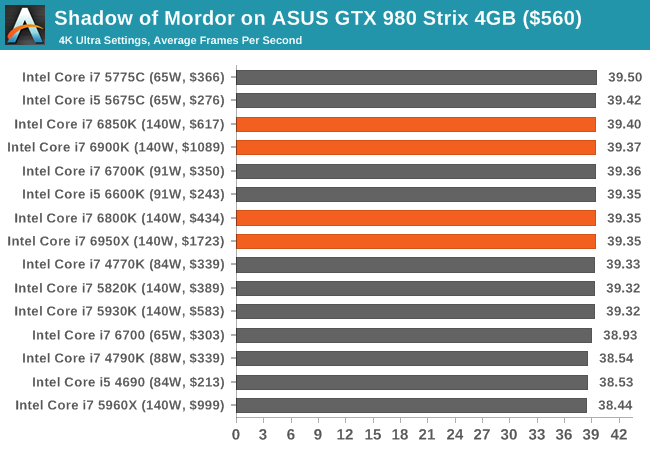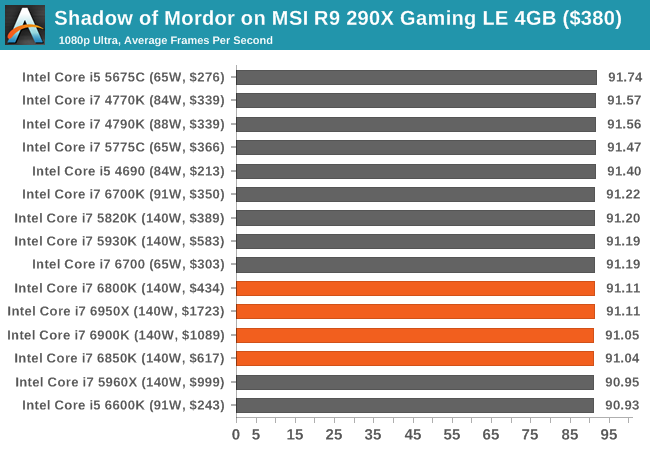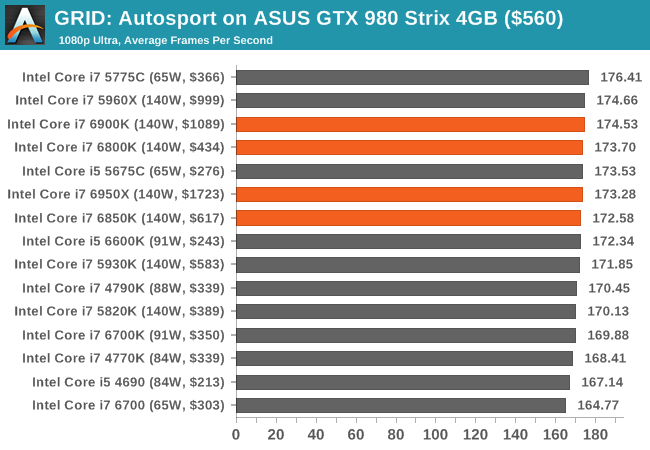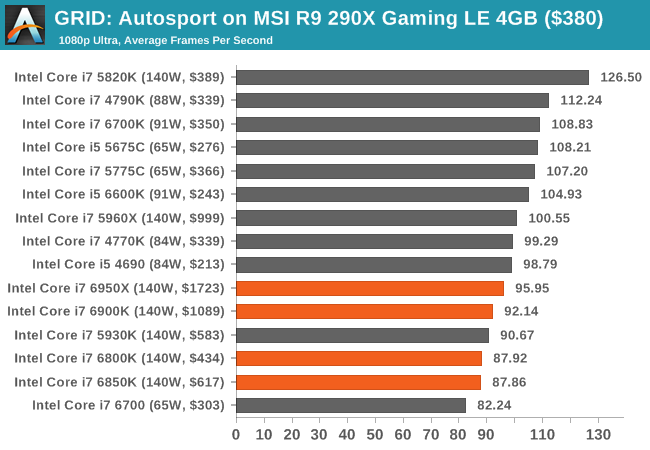The Intel Broadwell-E Review: Core i7-6950X, i7-6900K, i7-6850K and i7-6800K Tested
by Ian Cutress on May 31, 2016 2:01 AM EST- Posted in
- CPUs
- Intel
- Enterprise
- Prosumer
- X99
- 14nm
- Broadwell-E
- HEDT
GRID: Autosport
No graphics tests are complete without some input from Codemasters and the EGO engine, which means for this round of testing we point towards GRID: Autosport, the next iteration in the GRID and racing genre. As with our previous racing testing, each update to the engine aims to add in effects, reflections, detail and realism, with Codemasters making ‘authenticity’ a main focal point for this version.
GRID’s benchmark mode is very flexible, and as a result we created a test race using a shortened version of the Red Bull Ring with twelve cars doing two laps. The car is focus starts last and is quite fast, but usually finishes second or third. For low end graphics we test at 1080p medium settings, whereas mid and high end graphics get the full 1080p maximum. Both the average and minimum frame rates are recorded.
Middle-Earth: Shadow of Mordor
The final title in our testing is another battle of system performance with the open world action-adventure title, Shadow of Mordor. Produced by Monolith using the LithTech Jupiter EX engine and numerous detail add-ons, SoM goes for detail and complexity to a large extent, despite having to be cut down from the original plans. The main story itself was written by the same writer as Red Dead Redemption, and it received Zero Punctuation’s Game of The Year in 2014.
For testing purposes, SoM gives a dynamic screen resolution setting, allowing us to render at high resolutions that are then scaled down to the monitor. As a result, we get several tests using the in-game benchmark. For low end graphics we examine at 720p with low settings, whereas mid and high end graphics get 1080p Ultra. The top graphics test is also redone at 3840x2160, also with Ultra settings, and we also test two cards at 4K where possible.


















205 Comments
View All Comments
h4gfish - Monday, June 13, 2016 - link
> This combination of colors tends to go down well with whoever loves gold,> perhaps indicating that Intel is looking at a new kind of premium customer.
Whom do you mean by this 'new kind of premium customer'? Indians? Middle easterners? New York Italians? Rap stars? Or is it just that enterprise buyers don't tend to pay much attention to packaging? Maybe it's just me and my stereotypes, but I heard a 'sneer' in that sentence that is possibly unintentional.
Witek - Thursday, June 16, 2016 - link
I still think overclocked i7-3930K provides awesome value, 6850K is more expensive, absymally faster, and not that much more power efficient. Only good reason is if you care about AVX2, few additional special instructions (like ADDX, FMA3, etc), improves AES speeds and random numbers generation, or PCI 3.0 (3930K only supports PCI 2.0). But in generic applications speed improvements are 10-15% on average. Not worth 2-3 times money.The price of 6950X is a joke, and it is better probably to get some Xeon (or two) at that price point. I understand making these chips is very expensive, but it is not practical to sell them at these prices.
SanX - Tuesday, June 21, 2016 - link
Did I correctly understood this article mentions that if you use AVX instructions then overclocked freq must be up to 300 MHz less, which basically means that overclock is not possible? And did Ian use water cooling or all was on air?SlyNine - Wednesday, June 22, 2016 - link
Pick up chicks easier. They loves the core count.spooh - Thursday, August 4, 2016 - link
Any clues, if Anniversary update supports Turbo Boost Max?